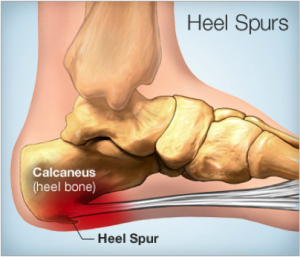17 Dec Heel Spurs
As the warm weather is upon us, we start to wear shoes that are not appropriate for our feet and begin to experience foot and heel pain. One of the most common misdiagnosed conditions we see in the clinic is heel spurs. Let us talk about effectively managing and treating heel spurs.
Heel spurs are basically calcium deposits that form on the underside of the heel, these can be visible on x-ray.
Heel spurs are often caused by strains on foot muscles and ligaments, stretching of the plantar fascia, and repeated tearing of the membrane that covers the calcareous.
Risk factors for heel spurs include:
- Walking gait abnormalities, which place excessive stress on the heel bone, ligaments, and nerves near the heel
- Running or jogging, especially on hard surfaces
- Poorly fitted or badly worn shoes, especially those lacking appropriate arch support
- Excess weight and obesity.
Symptoms of Heel Spurs
Heel spurs often cause no symptoms, but heel spurs can be associated with intermittent or chronic pain — especially while walking, jogging, or running — if the spur gets irritated it then becomes inflamed and causes pain with the associated surrounding tissue.
The pain associated with heel spurs is often described as a knife or pin sticking into the bottom of their feet when they first stand up in the morning — a pain that later turns into a dull ache.
Treatment of heel Spurs
Treatment tends to consist of ant inflammatories, rest, change of footwear, plus manual therapy to take the pressure off the surrounding tissue. Self-management such as rolling your foot on a golf ball or ice water bottle can also help.
For further information or help if you suffer from a suspected heel spur please contact the team at Complete Healthcare Sunbury.


